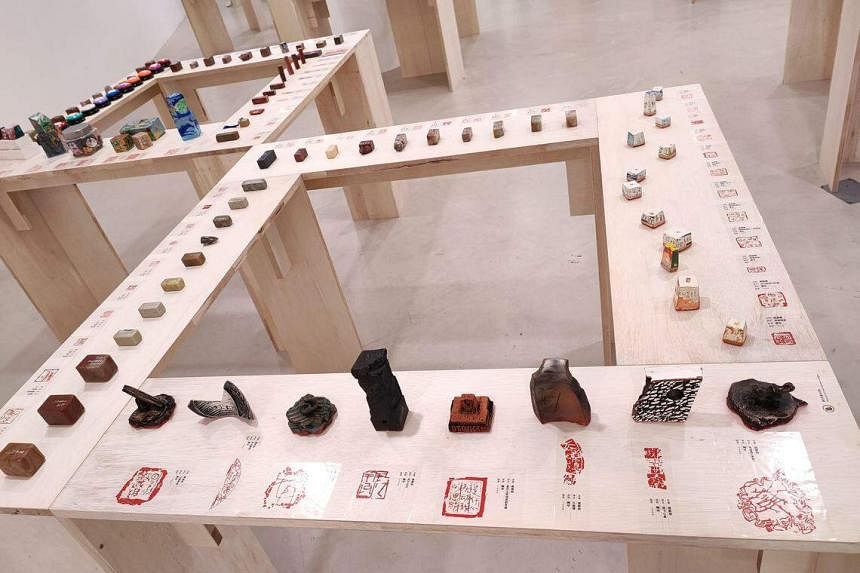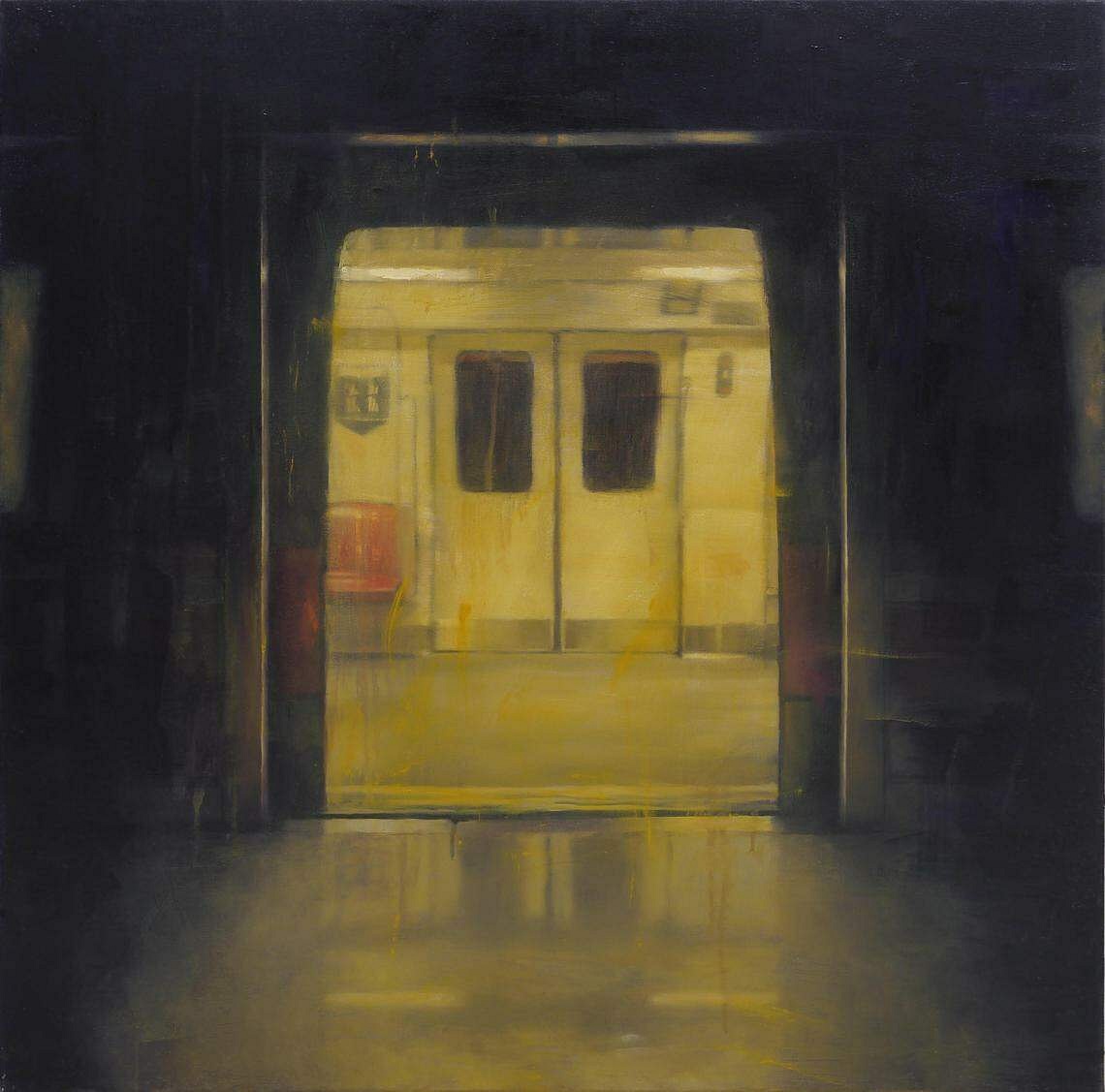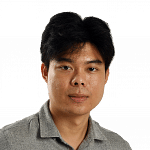Residual: Lee Wen & Jason Wee
This fascinating exhibition by non-profit The Institutum features never-before-seen works by local performance art icon Lee Wen (1957 to 2019), some of which are on loan from his Japanese wife and artist Satoko Lee.
The stars of the show are without a doubt Lee’s colour pencil on paper drawings, which are fanciful, complex and thoroughly absorbing in the images’ relationship with the poetic meditations that he has scrawled across the canvas.
In one plea embedded in a man’s sisyphean effort to push a rock up a hill, he says: “Dear Life/I want to live/Dear Death/I’m ready to die/Dear Friend/can I help you/Dear Enemy, can you help me?”
In another, next to a person shot with arrows in the manner of Saint Sebastian, he writes: “I look good without make-up, body paint or hairdo gloom/mirrors in my heart no need for light but love for sparks.”
This self-affirmation is perhaps a reference to his trademark Yellow Man performances, in which he is covered head to toe with paint.
Curated by Dr Karin Oen, head of the department of art history at Nanyang Technological University’s school of humanities, the exhibition takes as the starting point the friendship between Lee and younger artist and writer Jason Wee, developed during their joint participation in the Contemporary Art Japan artist-in-resident programme in Saitama in 2013.

During their month-long stay, they lived and worked side by side. Lee, who received the Cultural Medallion in 2005, was not above performing his works to just an audience of one.
Dr Oen has also included Lee’s journals, in which there are numerous studies of his own hands and illustrations in a cartoonish aesthetic perhaps unexpected from his public persona. A display in the rear of the gallery plays live recordings of his experimental music.
On the connection between Lee and Wee, who founded artist library and event space Grey Projects, Dr Oen says: “Lee’s writing is a beautiful thread through much of his work, whether it is diaristic, poetic or lyrical. This was one of the most interesting connections to Wee’s practice, where each of them relied on writing and then purposefully obscured and embedded it in their visual and performative work.”

Where: 1st Floor, Gillman Barracks, 7 Lock Road
MRT: Labrador Park
When: Till Oct 15, 11am to 6pm, Wednesdays to Sundays
Admission: Free
Info: str.sg/icZp
Carving Possibilities: An Exhibition By The Siaw-Tao Seal Carvers

More than 300 seals of all shapes and sizes have been collected in this first major seal exhibition that aims to take stock of the art form’s practice in Singapore.
Though probably one of the first Chinese art forms to take root here, seal carving has been peripheral to the country’s art historical narrative.
But in the splash of crimson and mysterious scrawls, curator Michelle J.N. Lim has found hidden worlds, which Lim says are “simultaneously poetic, sculptural, imagistic yet also possesses a rich cultural legacy”.
Lim’s prompt for the members of the Siaw-Tao Chinese Seal Carving, Calligraphy and Painting Society – established in 1971 – was “the possibilities of seal carving”.
This led to the creation of seals made of non-traditional media, such as antique mahjong tiles and carved cement, and with non-traditional scripts, including simplified Chinese, Burmese and Malay in Jawi script.
Proving that the art form here has evolved beyond its Chinese conventions, they also incorporate local colloquialisms and decorative motifs.
Mr Tan Yong Jun, 30, one of the society’s youngest seal carvers and its secretary, says: “Today, seal carving in Singapore has become almost entirely independent of practice in China.”

Where: de Suantio Gallery, Level 1 School of Economics, Singapore Management University, 90 Stamford Road
MRT: Dhoby Ghaut
When: Till Oct 1, 10am to 7pm daily
Admission: Free
Info: siawtao.com
Not Gallery’s penultimate exhibition

Loosely related to one another, the 10 works in this intimate show are selected by gallery founder Lim Hong Wei.
Boo Sze Yang’s 2013 alternative portrait of Singapore’s founding prime minister Lee Kuan Yew, The Father X, dominates the space.
The oldest work on show is the late Lim Mu Hue’s chiaroscuro oil self-portrait, likely painted in the pre-independence tumult of the 1950s, which retains some of the sculptural quality of his trailblazing woodcuts.
Joel Seow, the youngest artist at 27, shows his 2017 work, Our Secret Desire Is For A Change In The Order Of Things. In the diptych, an MRT carriage is turned into a bedroom with the shutting of doors and the addition of curtains, collapsing the public and the private.


Lim Hong Wei says this will be Not Gallery’s penultimate exhibition as its lease at Bras Basah Complex runs out in November. The gallery will continue online and in collaboration with boutique spaces, such as pop-ups in antique shops.
Where: Not Gallery, 02-41 Bras Basah Complex, 231 Bain Street
MRT: Bugis
When: Till Oct 8, noon to 6pm, Mondays, Tuesdays, Thursdays and Saturdays; 1 to 5pm, Sundays
Admission: Free
Info: str.sg/icZG


